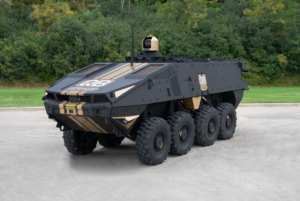General Dynamics Land Systems [GD] next week will unveil its new StrykerQB technology demonstrator, a hybrid-electric platform designed as a robotic controller vehicle.
Scott Taylor, the company’s director of U.S. business development, told
Defense Daily the new platform builds off the StrykerX demonstrator unveiled last year and was informed by Army feedback and the service’s human-machine integration initiative.

“Last year, StrykerX was something of an infantry carrier vehicle and the Army really wasn’t prepared for that. They just didn’t see a need for it. But what we know the Army is in dire need for is a robotic controller vehicle that can provide multi-robotic control for their human-machine integration campaign plan that they’re working on, bringing exponentially more capability to the fight and formations by pairing manned and unmanned formations,” Taylor said.
GD Land Systems will bring StrykerQB to next week’s Association of the United States Army’s (AUSA) annual conference in Washington, D.C., the same event where the company rolled out its StrykerX and AbramsX demonstrators last year (Defense Daily, Oct. 4 2022).
Company officials told Defense Daily last year that StrykerX and AbramsX were intended to highlight new capabilities that could be applied as upgrades to existing fleets or for new combat vehicle programs the Army may pursue.
Taylor noted the Army’s campaign of learning for its Robotic Combat Vehicle (RCV) effort has involved using M2A3 Bradleys as robotic controller vehicles for the surrogate prototypes it has worked with, including GD Land Systems’ Tracked Robot X-Ton (TRX), which informed the opportunity to build out the StrykerQB demonstrator.
“It was very clear that lots of times they were trying to jam into an existing vehicle with a very small space not designed for that kind of visibility it takes to control multiple robots at the same time, both air and ground,” Taylor said.
The Army last month selected GD Land Systems’ TRX as well as offerings from Textron Systems [TXT], Oshkosh Defense [OSK] and McQ Inc. for the first phase of its RCV competition, with each company tasked to deliver two prototype platforms by next August (Defense Daily, Sept. 21).
Taylor said he doesn’t see the Army as “ready to start putting cash on the table for a robotic controller vehicle,” adding GD Land Systems would like to see the platform as part of experimentation efforts for the Army’s human-machine integration initiative.
“We see an opportunity here to learn with the Army whether the StrykerQB could be part of that and provide a nascent solution for that human-machine integration,” Taylor said.
The StrykerQB demonstrator is “substantially overhauled and reinvented” from StrykerX, Taylor noted, detailing some of the enhancements from the previous platform.
“It was a substantial relook. A lot of the goodness that was in StrykerX, in terms of increased size, weight [and] power capabilities, were sort of capitalized upon. And then we looked at, instead of an infantry carrier vehicle, how could we create that area or that space where you could do multi-robotic control,” Taylor said. “There are some enhancements with [StrykerQB] in terms of the safety and functionality of the vehicle, an improvement and maturation off of last year. Beyond multi-robotic control, there are some enhancements in terms of 360-[degree situational awareness].”
Taylor said StrykerQB features a Safran-built sight capability integrated on the platform to support the situational awareness required to operate robotic platforms in the field.
“The large screen terminals that are in the back [of the vehicle] that enable the robotic control can now see through any one of those sights on the vehicle or integrated into its 360[-degree situational awareness],” Taylor told Defense Daily.